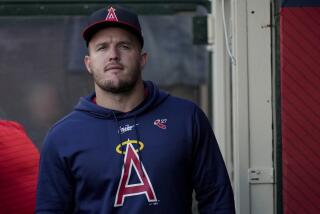Remembering Those Girls of Summer
The New York-based Women’s Sports Foundation is drumming up support for a permanent display in the Baseball Hall of Fame at Cooperstown, N.Y., honoring women’s professional baseball.
Women’s professional baseball?
Those older than yuppies and baby boomers may remember that during the war years (that’s World War II) and for a few years after, the All-American Girls Baseball League flourished.
“I’d never heard of it myself until I came to work here,” said Ted Spencer, who became curator at the Hall of Fame five years ago. “It’s fascinating,” he added. Spencer said he learned only recently, while researching the league rosters, that a woman who had been his gym teacher in high school had been a professional baseball player.
Chicago Cubs owner Philip K. Wrigley established the league in 1942 to keep the ballparks open while men were away at war. Recruiting camps were organized in the United States and Canada and play began in May, 1943, with four teams, the Rockford (Ill.) Peaches, South Bend (Ind.) Blue Sox, Kenosha (Wis.) Comets and Racine (Wis.) Belles.
By 1948 the league had expanded to 10 teams in the Midwest with attendance greater than 1 million. Play had begun as a modified version of softball, but evolved into baseball with overhand pitching. “. . . You should see how well the gals field and throw,” said league president Max Carey, a former manager of the Brooklyn Dodgers, in a Los Angeles Times article in January, 1946. “We have girl pitchers who can curve a ball and throw knucklers.” Carey also noted that “the gals had learned to make plays faster than many a boy I saw in the major leagues.”
Nevertheless, Wrigley wanted ladies, not tomboys in the league, as one player explained, and the women were given strict rules for dress and conduct off the field and were supervised by chaperons. Wrigley’s wife designed the uniforms--pastel blouses and short flared skirts with knee socks and baseball shoes--and brought in instructors from Helena Rubenstein to teach manners and grooming to the players. Of this, one player, Dottie Collins of the Fort Wayne, Ind., Daisies, said, “We all wanted to play ball so badly that we could endure the charm school.
“Women athletes really weren’t accepted in those days, but we could handle that,” Collins said. “We just played great baseball.”
Since most of the women had only played softball, former major and minor league ballplayers--all men--were recruited as managers.
As the league grew, seasons became something of an endurance feat--110 games long, with games six nights a week and double-headers on Sundays. There were five days off a season. The teams also played exhibition games at Army camps and hospitals and, occasionally, played exhibitions against men’s teams. Players were paid salaries ranging from $40 to $100 a week.
In 1944, with the end of the war in sight and the men’s major leagues still doing well, Wrigley sold the women’s league, and the new owner soon resold, back to individual business people in the various team cities. The league continued to grow and succeed for a few years, but by 1954, promotion and recruiting had slackened, television had captivated the American public, and the league ended its last season in August of that year.
The Women’s Sports Foundation included a history of the league in its current newsletter and suggested that people who think it should be in the Hall of Fame should write.
The Cooperstown people don’t need to be persuaded. Asked if the Hall of Fame had plans for an exhibit about the All-American Girls League, curator Spencer said, “The answer is absolutely. We’re not just showing the major leagues. We should be showing baseball. There’s no opposition within the staff here (to an exhibit on women in the sport). It’s going to happen.” But Spencer has two problems: “I don’t have the space and I don’t have the materials. Right now all I’ve got is a set of (Girls League) baseball cards.”
Spencer said the museum has plans for expansion within the next couple of years, which will provide space for the women’s exhibit as well as some other new ones. The display will include other information about women in baseball--some have been minor league administrators and umpires for example--but the focus of the exhibit will be the the All-American Girls Baseball League, Spencer said.
The problem of materials is less easily solved. “If someone would deluge us with old uniforms, it’d be spectacular,” Spencer said. Other possibilities for display would be special bats and balls, such as autographed ones. When people offer materials like scrapbooks and old photographs, the museum makes copies and returns the originals, he said. Anyone who would like to offer information or material on women’s baseball and particularly on the All-American Girls Baseball League to the Hall of Fame may write Spencer at Box 590, Cooperstown, N.Y. 13326.
More to Read
Go beyond the scoreboard
Get the latest on L.A.'s teams in the daily Sports Report newsletter.
You may occasionally receive promotional content from the Los Angeles Times.










